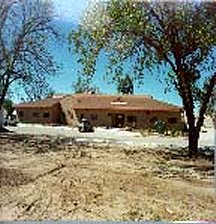Arizona Veterinary Diagnostic Laboratory
Assisting Arizona veterinarians and the public
A bull sickens and dies out on the range. A cow goes into fatal convulsions.
Did they eat something poisonous or did a virus kill them? Was it a
nutrient deficiency?  More
importantly, is the rest of the herd in danger? The five specialists
and their staff at the Arizona Veterinary Diagnostic Laboratory in Tucson
run tests on animal tissues every week to answer those questions and
others, to help protect animal health in Arizona. More
importantly, is the rest of the herd in danger? The five specialists
and their staff at the Arizona Veterinary Diagnostic Laboratory in Tucson
run tests on animal tissues every week to answer those questions and
others, to help protect animal health in Arizona.
"We're here to serve veterinarians, ranchers, farmers, pet owners,
zoo keepers and wildlife managers as well as federal and state agencies
such as Arizona Game and Fish, the Arizona Department of Agriculture,
the USDA, or the U.S. Fish and Wildlife Service," says Carlos Reggiardo,
director of the unit. "We were created mainly to serve Arizona animal
agriculture, but at the university level we also serve all of our college
herds and all of our researchers who are working with farm animals."
The laboratory is part of the Department of Veterinary Science and
Microbiology in the College of Agriculture, and is located at the West
Campus Agricultural Center along with the Aquaculture Pathology Laboratory
(see next article).
The veterinarians on staff examine a full range of animals each week,
from traditional livestock to exotic pets. The list includes beef and
dairy cattle, pigs raised for 4-H projects, horses, poultry, small ruminants
(sheep and goats), ratites (ostrich and emu), exotic reptiles and birds,
and other pet species.
"We have just as many urban as rural clients," Reggiardo notes. "This
is the unique thing about Arizona. It's really an urban state. We deal
with a great variety of animals here, not just one main agricultural
species, such as the swine in the Midwest."
The 14,000 square foot facility is equipped with necropsy rooms for
small and large animals, and four specialized labs for bacteriology,
virology, pathology and toxicology. The staff veterinarians have expertise
in different areas: three are pathologists, one is a microbiologist,
and another is a toxicologist. They handle all of the cases, from necropsies
(animal autopsies) and testing to communicating with clientele through
telephone calls and written reports.
"We mainly diagnose," Reggiardo says. "The attending veterinarian
actually gives the treatment. Thus we focus mainly on population medicine,
or the health of an entire herd or group. For example, say you are raising
calves and wonder why they're dying. You call up a veterinarian who
examines the herd and sends tissue samples to us, along with blood,
feed samples, and an entire animal. We diagnose the cause of death so
the vet can start treatment and prophylaxis [prevention] in rest of
the population. We try to help the vet by diagnosing death and losses
at any life stage."
Animals can die from mineral and nutritional deficiencies, from infectious
diseases caused by viruses, bacteria or fungi, or from poisonous causes
such as feed contamination. The laboratory also serves human health
and welfare by screening zoonotic diseases: those that can be passed
to humans.
"A lot of animal diseases can be transmitted to humans," Reggiardo
says. "In fact any animal, from domestic as well as exotic species,
has the potential of transmitting diseases to humans. Rabies and Salmonellosis
are the usual examples, but there is a long list of infectious and parasitic
diseases of animals which are considered zoonotic."
Reggiardo says the staff does a complete profile on every animal that
is sent to the lab, to uncover all causes of death. This involves performing
complete necropsies; removing tissue samples and testing them in each
of the four labs; and examining all of the test results to determine
whether the mortality was due to one cause or a combination of factors.
Nutritional diseases are a very common problem in Arizona. About half
the cases tested in the toxicology laboratory are really nutritional
testing according to Reggiardo. Most of the nutritional profiles focus
on production agriculture, and with increasing frequency, on horses.
For cattle, mineral deficiencies top the list. And surprisingly, copper
deficiency ranks high.
"Arizona has widespread copper deficiencies in ruminants," he says.
It's ironic that Arizona is known as the Copper State, because it is
also in a region with widely widespread copper deficiencies in cows
and sheep. Such deficiencies occur because of deficiencies in the soil
in some areas, or because of interference in its absorption by high
concentrations of other minerals in the plants."
Poisoning deaths in pets and wildlife are often intentional, caused
by insecticides, strychnine, poisonous baits or similar products. Accidental
poisonings are more common in livestock, caused by a wide range of agents,
from toxic plants to heavy metals to nitrate poisoning in irrigated
pastures.
Aside from diagnostic services, the lab also provides animal assistance
to schools for science classes, supports research projects throughout
the university, and assists Arizona Game & Fish with their studies of
wildlife populations.
"We do charge for our services, but just for operations," Reggiardo
says. "Everything else is state subsidy. This is a service that is open
to the public: we're improving the livelihood of people by improving
animal health."
Article written by Susan McGinley, ECAT, College of
Agriculture
This is part of the 1997 Arizona Experiment Station Research Report
This document is located at http://ag.arizona.edu/pubs/general/resrpt1997/veterinary_lab.html
Return to Index for 1997 report
Researcher:
Carlos Reggiardo
Department of Veterinary Science/Microbiology
(520) 621-2356
creggiar@ag.arizona.edu
|